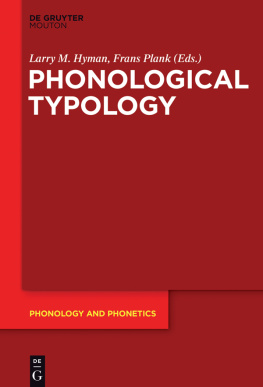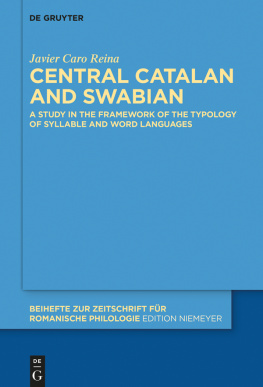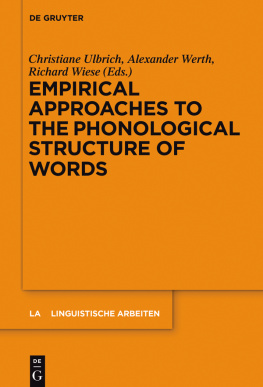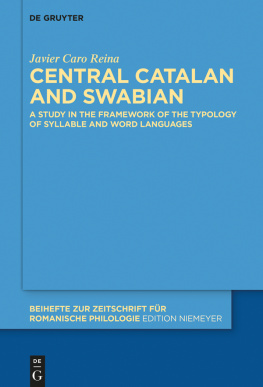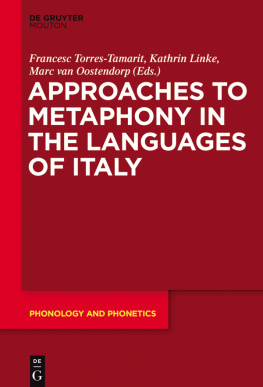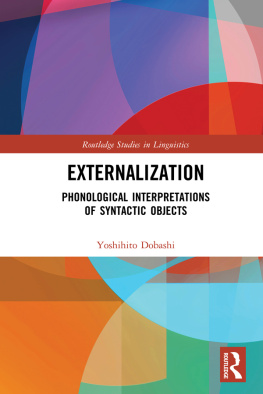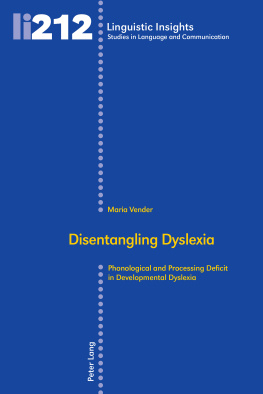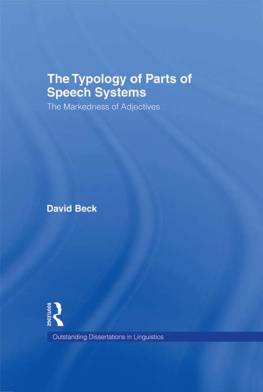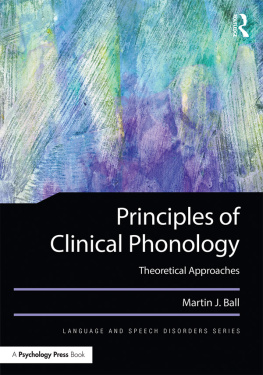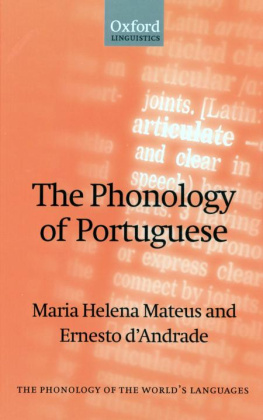Contents
Guide
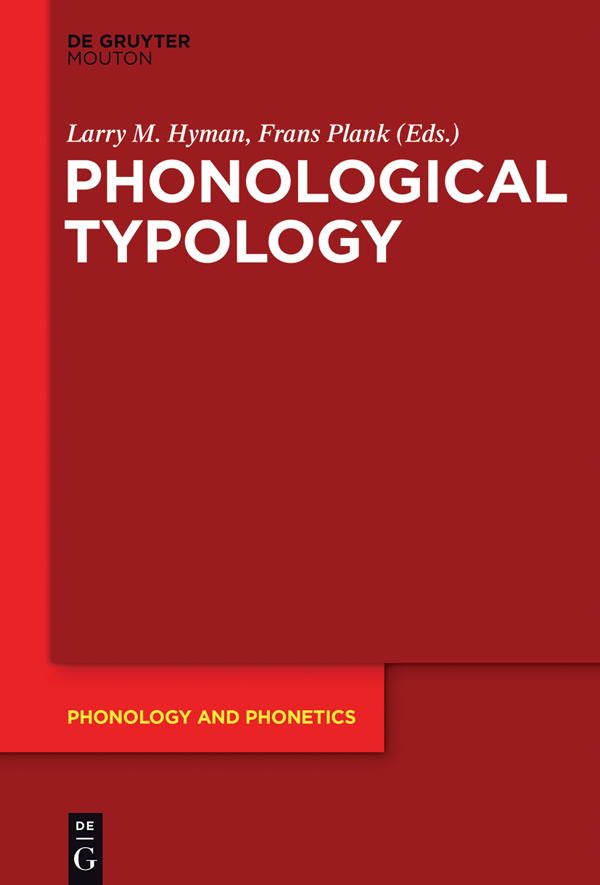
Larry M. Hyman and Frans Plank (Eds.)
Phonological Typology
Phonology and Phonetics

Edited by
Aditi Lahiri
Volume 23
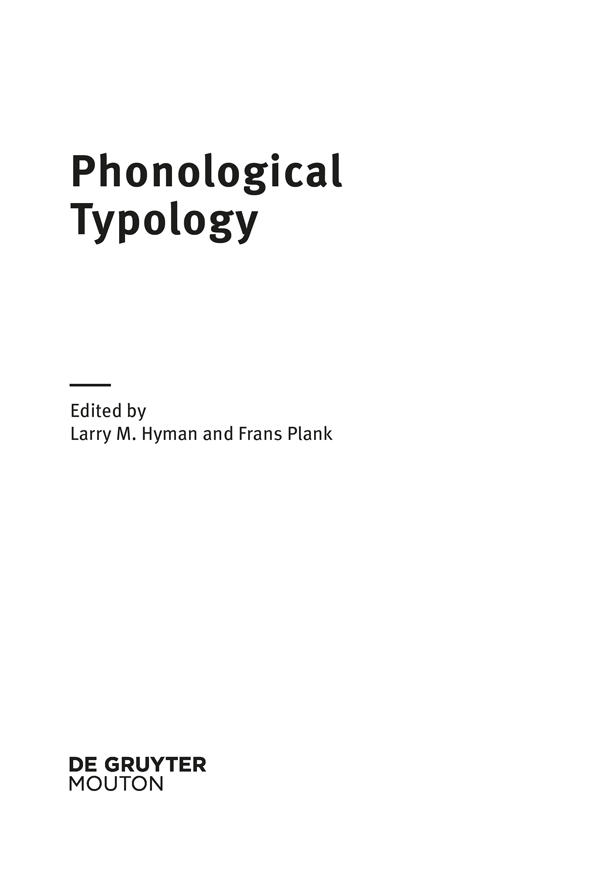
ISBN 978-3-11-044970-9
e-ISBN (PDF) 978-3-11-045193-1
e-ISBN (EPUB) 978-3-11-044992-1
ISSN 1861-4191
Library of Congress Control Number: 2018934237
Bibliografische Information der Deutschen Nationalbibliothek
The Deutsche Nationalbibliothek lists this publication in the Deutschen Nationalbibliografie; detailed bibliographic data are available on the internet http://dnb.dnb.de.
2018 Walter de Gruyter GmbH, Berlin/Boston
www.degruyter.com
Preface
This volume seeks to bring together two separate enterprises, typology and phonology, which have often gone their separate ways, even when apparently addressing each other. Although there has always been phonology in the many approaches to typology, there has always been far less of it than there has been of morphology and syntax. Particularly in recent times, during which phonological theory has flourished in many colours, the phonology in typological circles has centered either around segment inventories and basic phonotactics or limited itself to crudely categorising labels such as syllable- vs. stress-timed languages, something which would barely pass muster with phonological theorists, whose concerns have been deeper and usually more formal. On the other hand, despite the numerous and diverse languages that would typically inform phonological theorising, typological questions as such were rarely of major consequence, if raised at all.
If one sees value or at any rate promise in typology, the research programme for discovering and accounting for order in diversity, and if you see no principled reasons to doubt that linguistic diversity is about as orderly in phonology as in syntax and morphology (or at any rate inflection), this state of affairs is regrettable. Since this is how we see it, we felt obliged to lend a hand towards improving relationships.
In organised typology, the success of our efforts was limited. Though long involved in various capacities in the Association for Linguistic Typology (ALT), it looks like we and a few fellow campaigners have not been able to significantly raise the profile of phonology at ALTs biennial conferences or in its other activities. The two of us hit rock bottom when a workshop to boost phonology in typology that we suggested as part of an ALT conference a few years ago did not find favour with the programme committee, for reasons we ourselves found unconvincing. Reassuringly, the phonological record of Linguistic Typology , the journal we have helped to run for two decades, is better, but still comparatively modest.
Perhaps we had gotten hold of the wrong end of the stick, trying to proselytise in typological circles. Changing tack, for the present volume we sought out linguists who define themselves and are perceived first and foremost as phonologists. Though rarely meeting at typological get-togethers and not so far published in LT , we were still expecting typological awareness rather than complete innocence, because our remit for them was as follows: Do typology! Present a sample piece of work appropriate for a workshop and subsequent publication as you think it can and ought to be done in state-of-the-art phonology!
And here we go. After two scene-setting and background-providing contributions from the editors (Hyman; Plank), the phonologists assembled here, typologically aware or indeed expert, address metatheoretical issues of what it means to do phonological typology (Kiparsky; Maddieson). Through different methodologies, they explore the possibilities of and limitations on segmental alternations (Heinz; Brohan & Mielke), seek system, not in segment inventories as such, but in featural contrasts, and find variability, though not randomness, of contrastive systems in language change and language acquisition (Lahiri; Dresher, Harvey, & Oxford; Broselow) and seek limitations on diversity and change concerning microvariation in tonal accent systems in North Germanic (Riad). An effort at conceptual clarification of what it is that can be typologised in prosodic typology segments, constituents, their alignments concludes (Gussenhoven).
Typologys subject matter is vast: for EVERYTHING about language units, paradigmatic systems, rules for and constraints on forming prosodic constituents (syllables, feet... anything syntagmatically complex without or with meaning) we need to ascertain whether it is variable or invariable, and if it is variable we want to know whether it varies independently or co-varies with anything else. Despite the extensive knowledge accumulated in phonology over the past century, phonological typologists still have considerable work cut out for them for an unforeseeable time to come. The present collection will have served its purpose if it gives them encouragement and guidance. Naturally, phonological awareness or indeed expertise of none-too-basic a nature will be an asset for those planning to join in this enterprise: in phonology no less than in syntax and morphology, generalising is futile if the particulars over which one generalises are inadequately analysed.
This volume derives from a workshop in Somerville College, University of Oxford, on 1113 August 2013 (funded by a European Research Council Advanced Investigator Grant to Aditi Lahiri). Subsequent to the preparation of this volume, a survey monograph of the same title appeared, by Matthew K. Gordon (Oxford University Press, 2016), adding another voice to the small chorus of performers striving to bring the adjective into harmony with the noun (or vice versa) of our shared title. A big thanks from all of us who were present goes to Aditi Lahiri, for there is no better host. There also is no better series editor for this sort of thing either, cruel but fair with her editors and authors: A thank you to our dear friend and colleague Aditi Lahiri in this capacity, too.
We might as well dedicate this collection to her on the occasion of a round birthday that must not go unmarked...
Larry M. Hyman
Frans Plank
Contributors
Anthony Brohan
Google, Mountain View, CA 94043, USA
Ellen Broselow
Department of Linguistics, Stony Brook
University, Stony Brook, NY 11794-4376, USA
B. Elan Dresher
Department of Linguistics, University of
Toronto, Toronto, Ontario, Canada M5S 3G3
Carlos Gussenhoven
Department of Linguistics, Radboud
University, PO Box 9103, 6550 HD Nijmegen, The Netherlands
Christopher Harvey
Department of Linguistics, University of
Toronto, Toronto, Ontario, Canada M5S 3G3
Jeffrey Heinz
Department of Linguistics and Institute of
Advanced Computational Science, Stony Brook
University, Stony Brook, NY 11794-4376, USA
Larry M. Hyman
Department of Linguistics, University of
California at Berkeley, Berkeley, CA 94704, USA
Paul Kiparsky
Department of Linguistics, Stanford University,
Stanford, CA 94305-2150, USA
Aditi Lahiri
Faculty of Linguistics, Philology and Phonetics,
University of Oxford, Oxford OX1 2HG, UK
Ian Maddieson
Department of Linguistics, University of New
Mexico, Albuquerque NM
Jeff Mielke
Department of English, North Carolina State
University, Raleigh, NC 27695-8105, USA

